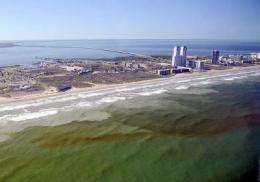Forecast system to warn of toxic algal outbreaks along Texas' shoreline

Texas officials and coastal managers will now receive early notice of outbreaks of toxic algae that threaten public health and affect beach and fishing activities along the coast. Weekly bulletins generated by the NOAA Harmful Algal Bloom Operational Forecast System are based on observations from state partners, coupled with models, imagery and data from NOAA's powerful tide and current and weather systems.
"Early notification of blooms is essential, and knowing that a bloom is occurring offshore provides our resource managers with sufficient time to coordinate with other responding agencies and formulate a plan before blooms hit the beaches," said Meredith Byrd, harmful algal bloom response coordinator for the Texas Parks and Wildlife Department.
The most common harmful algal bloom that occurs in the Gulf of Mexico is known as "red tide" and is caused by the algal species Karenia brevis. Occurrences of red tide have historically resulted in fish and marine mammal deaths, shellfish contamination and even human health risk in the form of respiratory distress. Economic impacts of harmful algal blooms in the United States average $75 million annually including impacts on public health costs, commercial fishing closures, recreation and tourism losses and management and monitoring costs.
Recognizing the need to provide harmful algal bloom information on a more consistent basis, NOAA worked to transform this former demonstration project into a fully operational system. Earlier this year, test bulletins of this system successfully tracked and informed Texas officials about the location of a harmful Dinophysis algal bloom that closed Texas' shellfisheries. NOAA has had an operational forecast in the eastern Gulf of Mexico for harmful algal blooms off the Florida coast since 2004 and with the expansion of the operational system, analysts will be available to review conditions daily with coastal managers from all of the Gulf of Mexico states.
"Ecological forecasting is crucial to protecting human health, the nation's economy and our enjoyment of our special coastal places," said Richard Edwing, director of the Center for Operational and Oceanographic Products and Services. "This new system is another way NOAA helps equip our coastal managers with information and tools to plan for and recover from the costly affects harmful algal blooms cause to their communities."
More information: NOAA Harmful Algal Bloom Operational Forecast System: www.co-ops.nos.noaa.gov/hab
Provided by NOAA














